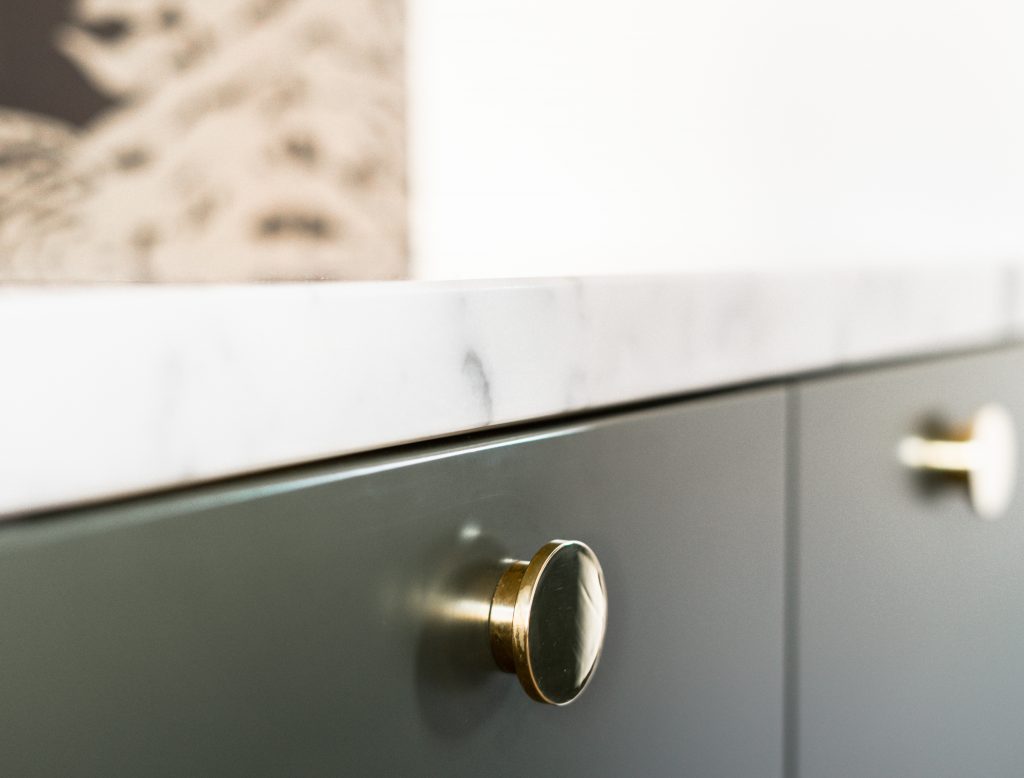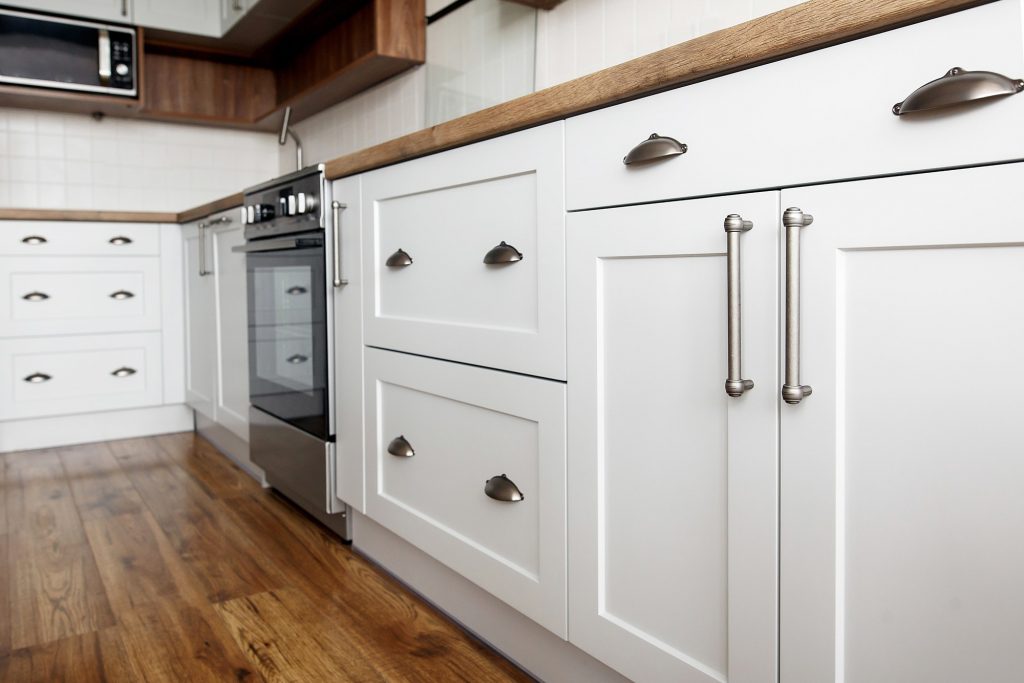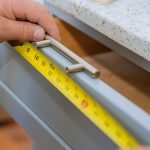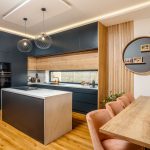Hardware has a major impact on the overall look and feel of your kitchen. Well-matched, updated hardware can complement your design with a touch of elegance while old, flaking or poorly-matched hardware can ruin the theme and make the kitchen look dated. To give your kitchen design that winning touch, you can customize cabinet hardware by either replacing or updating.

How to Paint Cabinet Hardware
Remove your cabinet hardware
It’s never a good idea to try to paint your knobs and pulls while they’re still attached to the cabinets and drawers. It might seem like an extra step, but the rest of the process will be infinitely easier with the hardware separated. Remove any hardware you plan to paint, including door hinges. Then take your drawer pulls, hinges, and cabinet handles to an area with good ventilation and protection from the elements, like a patio. Lay down a tarp or piece of cardboard to keep paint and products off of your table or floor.
Clean with a degreaser
Use synthetic steel wool (SSW) to remove any old finish and get the surfaces nice and smooth. Removing grime, grease, and oil is essential to getting a lasting finish with your new paint. If you have a hard time removing the old finish, try stripping it with a stripping gel. Particularly difficult pieces might require the application of heat from a heat gun or boiling water. Then, clean all of the hardware thoroughly with a TSP wash or a degreaser.
Rinse and dry
Be sure to rinse away any remaining cleaner or water and allow the hardware to dry completely. This should take no more than half an hour in good weather. While the hardware is drying, don’t touch it. The oils from your hands can create a barrier that will prevent the primer and paint from sticking to the areas you’ve handled.
Apply a primer
Don’t skip the primer. Primer bonds your paint to the metal so that it will last as long as you need it to. Choose a spray primer that’s compatible with both the type of metal your hardware is made of and the paint you plan to lay over the primer. Oil-based primers or “bond coats” typically perform better in this application. Apply the primer in thin coats with a few minutes in between each coat to prevent drips and buildup. Be sure to apply in the crevices. If you have any imperfections in your primer, you can go over it lightly with 0000 steel wool.
Paint your hardware
Apply your paint in the same fashion you did the primer. Use thin coats and wait a few minutes between each coat. Spray each piece of hardware from different angles to make sure you cover every side and into the crevices. You might be tempted to apply a thicker layer to achieve fuller coverage, but your finish will be smoother and more professional if you build up thin coats instead.
Apply a sealer
Sealer is almost as important as a primer. It helps your paint last longer and survive all the handling that kitchen and bathroom cabinets are subject to. You can use a lacquer or a clear sealer that’s compatible with your paint. If you’re unsure, test a single piece before continuing with the rest. A lacquer can give you more shine and make future cleaning easier while a sealer can give a more subtle sheen. Consider the look and convenience you want when you make your choice.
Allow the cabinet hardware to cure
The easiest way to cure hardware for many people is to let it sit overnight if it’s protected. Give your hardware at least eight hours or whatever is recommended on the primer, paint, and sealer you used. Once your hardware is cleaned, primed, painted, sealed, and cured, it’s time to put it back where it belongs and admire your beautiful new cabinets.
How to Choose Kitchen Cabinet Hardware to Match Décor

Follow your theme
The hardware you’d find in a country or Italian kitchen is going to be different than the hardware you’d find in a contemporary or modern kitchen. Take some time to identify your kitchen’s theme and narrow your hardware search to styles and finishes that will complement your theme well. The massive range of hardware options will give you plenty to choose from within your theme.
Match your finish
You might not be getting all of your hardware at one time from the same retailer. If you are, you can get everything to match pretty easily. If not, make sure you’re comparing and matching finishes as accurately as possible. Matching your finishes will keep the look cohesive even if you end up with a mix of designs around the kitchen.
Knobs or pulls?
The general rule of thumb is that knobs are more subtle than pulls. They also take up less space. That makes knobs perfect for ornate and custom cabinetry because they won’t distract from the design or cover it up with a large piece of hardware. Pulls are perfect for less decorative drawers and cabinets that could use a bit more style or for sleek and modern custom cabinets where you want to accentuate the strong lines.
Check your appliances
Your cabinet hardware is probably not the only hardware in your kitchen. Take a look at your lighting, sink, faucet, and appliances. Some mixing of metal finishes is passable in kitchen design, but be sure to keep it subtle to maintain the beauty and cohesiveness of your theme.
Be aware of the appliances and fixtures in the kitchen. Pulls and knobs are not the only hardware in your kitchen. Take into account the finish on appliances, light fixtures, and your sink and faucet. While mixing metal finishes is trendy right now in kitchen design, be sure not to overdo it. If the colors clash, it could disrupt the cohesiveness of your kitchen and take away from the beauty of your new cabinets.
Refinishing Cabinet Hardware vs Buying New Hardware
When deciding to customize your cabinet hardware, there are a few factors to consider before you make any decisions about what to do with your existing hardware. First, look carefully at their current condition. How much scrubbing, scratching, and stripping will you have to do to refinish them? Is there any damage that makes refinishing impractical? Also, consider how much hardware you have. If you have a very large kitchen, it will take more work to refinish all the hardware, but it will also cost more to replace it all. Consider your budget and the result you’re hoping for. If you’re going for a 100% custom look, you might not be able to find it in a catalog.





